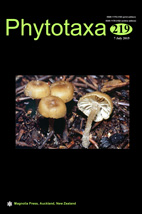Abstract
Bignonia is a genus of 28 species of Neotropical lianas. Most species are clearly characterized by morphological features, monophyletic and narrowly distributed. However Bignonia binata is polymorphic, polyphyletic and broadly distributed, from Mexico to Argentina. A detailed morphological survey of B. binata in the light of geographical and ecological data in its current circumscription recovered two clearly distinct morphological groups of plants. One group is found in Argentina, Paraguay and the Atlantic forest of Brazil, and characterized by non-winged stems, usually terminal inflorescences, usually non-glandular calyces, pantoaperturate pollen, narrowly elliptic fruits, and 1-winged seeds. The second group occurs in Central America and Amazonia and is characterized by winged young stems, usually axillary inflorescences, glandular calyces, inaperturate pollen, widely elliptic to circular fruits, and wingless seeds. The first group of plants corresponds to B. binata and the second group is recognized as another species, B. noterophila. Synonyms, morphology, distributions, and ecology are detailed for these newly circumscribed species. Lectotypes are designated for B. noterophila and several synonyms: Adenocalymma ocositense, Arrabidaea schumanniana, and Petastoma laurifolium.

